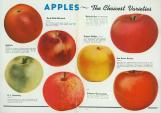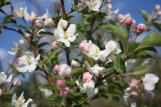14
NECTARINESNectarines are another popular crop in Grimsby. They are delicate to grow, but thrive in the Grimsby area because of growing conditions. Many people believe that nectarines are a crossbreed between a peach and a plum. This is not the case; they are instead a peach with different 'DNA'. It is possible for nectarines and peaches to grow together on the same tree. Nectarines are commonly smaller and sweeter than peaches. Unlike a peach, the skin of a nectarine is smooth and this intensifies the red colour. Nectarines can be mistaken for plums because of their smaller size and red skin.
15
PEARSThe pear is another fruit grown in very large quantities in the Grimsby district. Pears were grown for two markets. As the pear is less fragile than other tender fruits, it was and continues to be sold as fresh produce both locally and overseas. The factories also canned large numbers of pears for the local and overseas markets. With the closure in 2008 of the last canning factory in St. David's, Ontario, many pear orchards have been removed as the local canning market no longer exists.
16
Pears: Here are the Favourite Varieties20th Century, Circa 1940
Helderleigh Nursery, E. D. Smith Property, Winona, Ontario, Canada
 Credits:
Credits:Donated by the Niagara Fruit Institute
Grimsby Museum Collection
17
Settlers travelling west from the Maritimes may have carried pear seeds. Many pear trees in Canada have a European origin as this tree has grown in Europe for hundreds of years while some of the newer varieties have been developed in Canada. The Bartlett pear was originally grown in Berkshire, England in 1700. This well-known and popular pear is grown throughout the Niagara fruit belt. Other popular varieties of pears include Bosc, Anjou and Clapp.18
Pear Fruit21st Century, Circa 2008
Vincic Farm, Winona, Ontario, Canada
 Credits:
Credits:Niagara Fruit Institute
19
Un-Pruned Pear Tree21st Century, Circa 2008
Niagara Region, Ontario, Canada
 Credits:
Credits:Niagara Fruit Institute
20
Pear Blossoms21st Century, Circa 2008
Niagara Region, Ontario, Canada
 Credits:
Credits:Niagara Fruit Institute
21
APPLESBy 1870, apples were recognized as the most important fruit grown in Ontario. While apples were grown in all areas of the province, the majority of Ontario apples were not for sale within Ontario but for the overseas market, notably Great Britain.
During the late nineteenth and early twentieth centuries, apples were fairly easy to grow. Many farmers planted orchards resulting in strong competition between apple growers in Canada and the United States. Canadian apples kept better in storage and the flavour of the Canadian apple was preferred to the American apple. The American apple tended to be larger than the Canadian apple. By 1880 Canadian and American apples had replaced British apples as the most popular in Great Britain.
22
Apples: The Choicest Varieties20th Century, Circa 1940
Helderleigh Nursery, E. D. Smith Property, Winona, Ontario, Canada
 Credits:
Credits:Donated by the Niagara Fruit Institute
Grimsby Museum Collection
23
Apples: The Choicest Varieties20th Century, Circa 1940
Helderleigh Nursery, E. D. Smith Property, Winona, Ontario, Canada
 Credits:
Credits:Donated by the Niagara Fruit Institute
Grimsby Museum Collection
24
Apple Varieties1914
Ontario Department of Agriculture, Ottawa, Ontario, Canada
 Credits:
Credits:Grimsby Museum Collection
25
Rows of Apple Trees21st Century, Circa 2008
Niagara Fruit Institute Orchards, Winona, Ontario, Canada
 Credits:
Credits:Niagara Fruit Institute
26
Wild Apple Blossoms21st Century, Circa 2008
Niagara Fruit Institute Orchards, Winona, Ontario, Canada
 Credits:
Credits:Niagara Fruit Institute
27
Apples21st Century, Circa 2008
Niagara Fruit Institute Orchards, Winona, Ontario, Canada
 Credits:
Credits:Niagara Fruit Institute